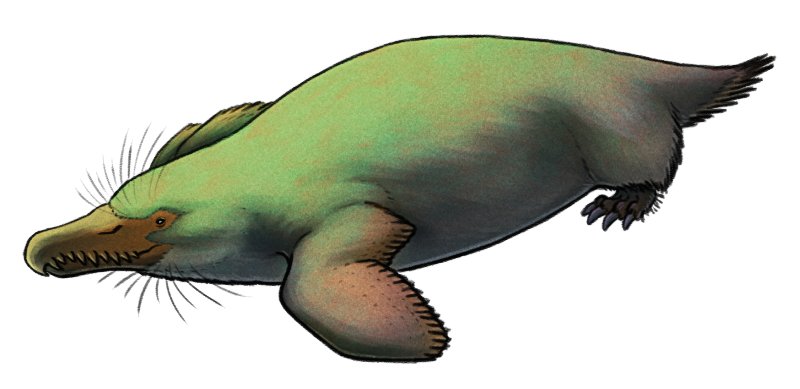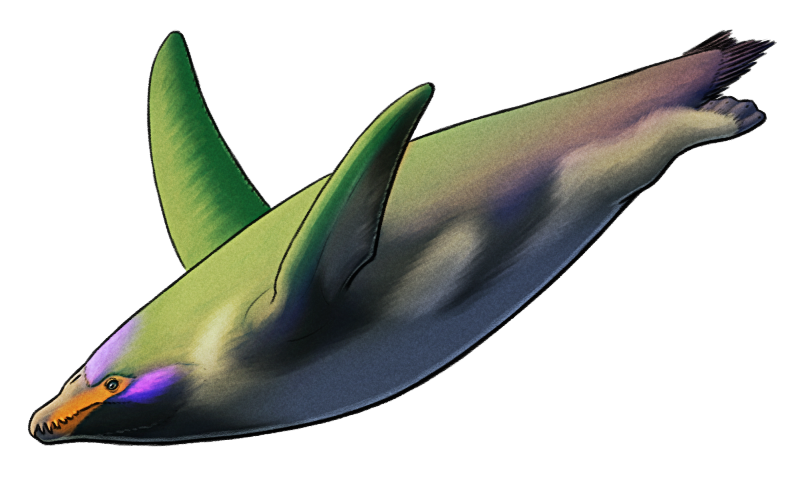Today’s #Spectember concepts come from three submitters: anonymous, Jonas Werpachowski, and Novaraptoria.

Despite having a convergent resemblance to penguins or gannetwhales, the humdertaker (Suchomergus pollinctor) is actually a distant descendant of modern hummingbirds.
Its ancestor was a hummingbird species similar to the tooth-billed hummingbird, with tooth-like pointed serrations along the edges of its beak – initially developed for fighting, but later co-opted for better catching insects. Some of these hummingbirds shifted their diet fully away from nectar and became aerial hunters more like their relatives the swifts, and one lineage that commonly fed on insects at the water’s surface began also snatching up aquatic prey like tadpoles and small fish.
These birds became larger kingfisher-like divers with waterproof feathers, and eventually some became increasingly aquatic, spending most their time swimming at the surface of lakes and rivers like mergansers or loons. These forms rapidly became flightless, specializing for penguin-like wing-based swimming, but due to their front-heavy build and ancestrally small legs also became completely unable to stand or walk on land, instead restricted to an ungainly motion somewhere between a tobogganing penguin and stiff-spined galumphing seal.
Growing up to about 2m long (6’6″), the humdertaker is a semi-aquatic ambush predator occupying a similar ecological role to small crocodilians. With a heavily serrated beak able to hold onto slippery prey, it feeds mainly on fish, amphibians, and crustaceans, but will also opportunistically snatch other animals from the water’s edge and scavenge on carrion – and like a giant aquatic version of a shrikes it often caches “larders” of surplus food on snags in the water.
Although it has a much slower metabolism than its nectar-fueled flying ancestors, it has retained some of their other biological quirks. Tolerance for very low oxygen and the ability to enter a torpor-like resting state allow it to hold its breath underwater for much longer than many other air-breathing vertebrates, and to better conserve its energy during periods of food scarcity.

One offshoot lineage of small humdertakers began using their beaks and wings to excavate burrows into the riverbanks, and gradually specialized more and more for digging rather than swimming.
The humderminer (Iposkapteryx werpachowskii) is an especially mole-like form, a fully subterranean tunneler with reduced eyes and broad shovel-like ‘flippers’. Only about 10cm long (4″), it primarily hunts worms and other small underground animals, and has retained somewhat iridescent plumage due to the structural benefits when moving through soil.

The humdingers are another offshoot from early humdertakers, specializing into even more aquatic lifestyles and eventually moving out from freshwater into the ocean.
Voragornis novaraptoriae here is one of the largest humdingers, about 5m long (16’4″). It’s a fully wing-propelled swimmer with a highly streamlined body, and its still-relatively-small legs are adapted into rudders and stabilizers similar to the hind flippers of turtles.
It’s an especially accomplished diver, able to reach depths of close to 2000m (~6600 ft), preying on soft-bodied deepwater cephalopods and fish. Lacking echolocation it mainly uses sight to hunt in the deep dark waters, looking for glimpses of bioluminescent prey.
Although humdingers are the equivalent of “whale-sized” compared to their much tinier hummingbird ancestors, they’re currently limited from growing much larger due to their reproductive requirements – these almost-fully-aquatic birds do still need to be able to haul themselves out onto land once a year to molt and breed.
Much like penguins humdingers undergo a seasonal “catastrophic molt“, replacing all their insulating feathers at once and being stuck on shore unable to swim for a few weeks at a time. This molting coincides with their nesting season, when females use their flippers to dig out a turtle-like nest on the shore – burying the clutches to incubate since their bulky bodies are too heavy to safely sit on them. They’ll guard the nests until they’ve completed molting, but then abandon them, leaving the young to hatch superprecocial and fully independent a few more weeks later.
